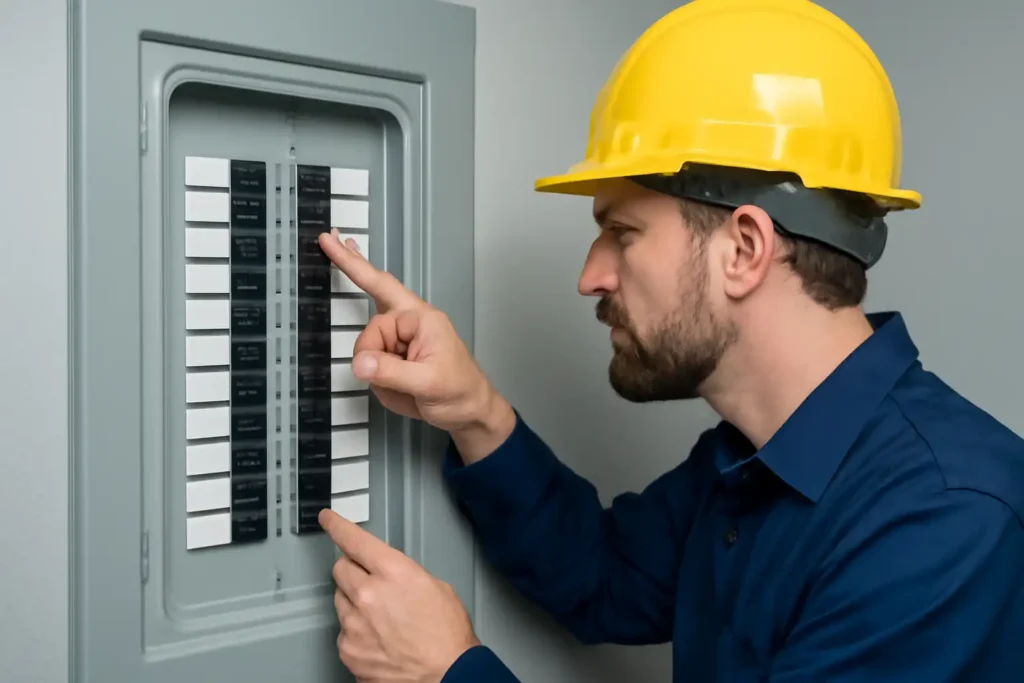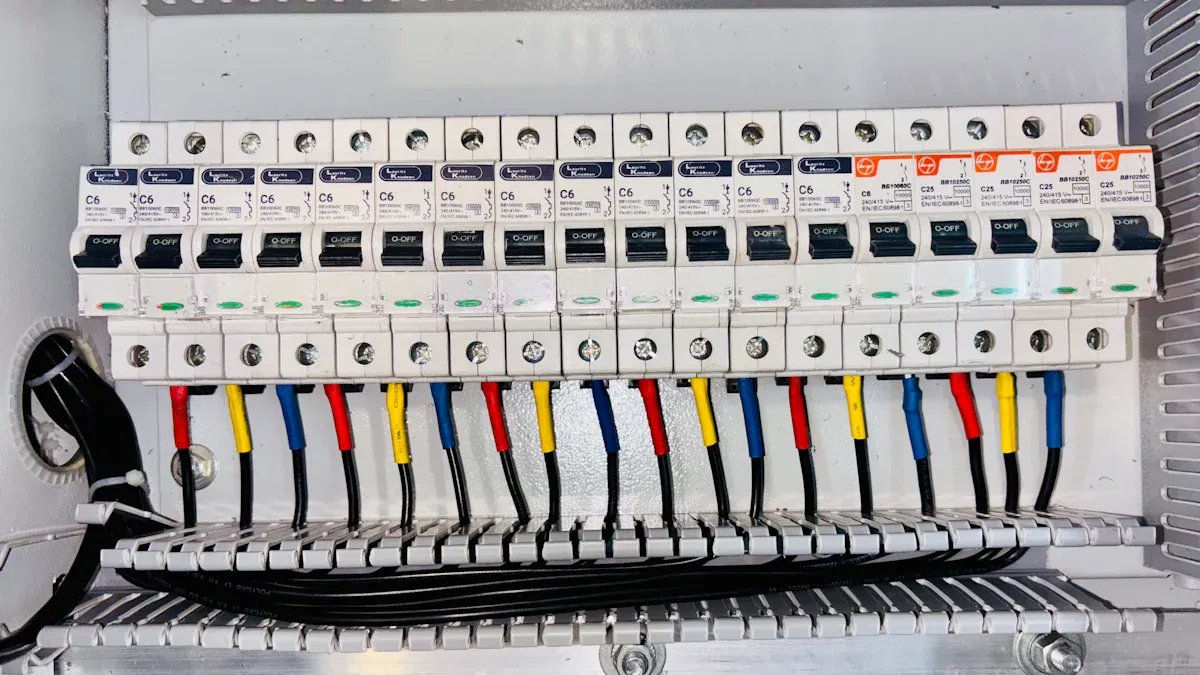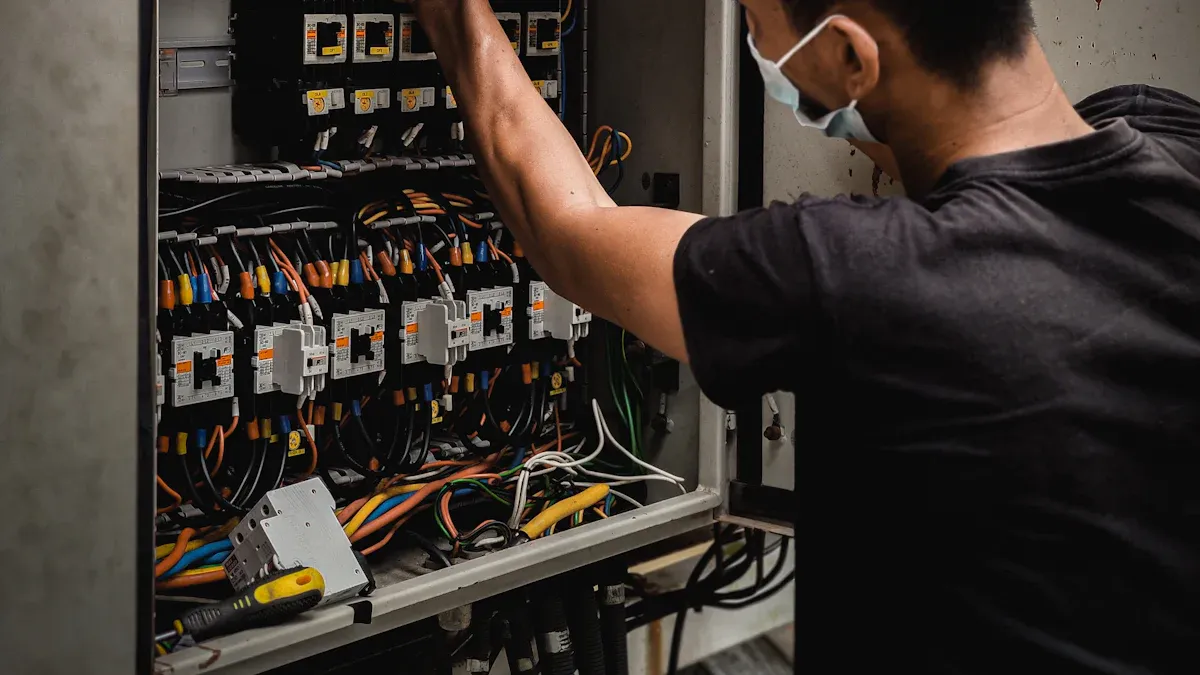Finding the circuit breaker in your home doesn’t have to be complicated. With the right tools and a little preparation, you can easily find the circuit breaker quickly and safely. Before you dive in, take a moment to think about safety. Did you know outdated breaker panels cause around 2,800 fires every year? These incidents lead to $40 million in property damage and even cost lives. Proper preparation can help you avoid these risks while making the process of finding the circuit breaker smoother. So, grab your tools and let’s get you started!
Key Takeaways
- Circuit breakers keep your home safe from electrical problems. They stop wires from getting too hot and causing fires.
- Get tools like a screwdriver and voltage tester first. These tools help you work safely and easily.
- Turn off the main power before opening the breaker panel. This is very important to stay safe.
- Write labels on your breakers after you find them. Labels save time and help in emergencies.
- If you don’t see the breaker box, look in places like the basement or garage. You can also ask your neighbors for help.
What is a Circuit Breaker and Why You Need to Find It
Purpose of a Circuit Breaker
A circuit breaker protects your home’s electrical system. It keeps your wiring, devices, and family safe from electrical dangers. If too much electricity flows, the breaker shuts off power. This stops overheating, fires, and damage to your devices.
Circuit breakers also stop short circuits. A short circuit happens when electricity flows the wrong way. The breaker cuts power to fix the issue and prevent harm. Some breakers have extra features. These include arc fault protection to stop sparks that cause fires. Others have ground fault protection to prevent shocks.
In simple terms, circuit breakers keep your home safe and your electricity working. Without them, small electrical problems could become big disasters.
Common Reasons to Find the Circuit Breaker
There are many reasons to find the circuit breaker. A common one is when a breaker trips and cuts power. This happens because of an overload or short circuit. To reset it, you need to find the breaker first.
Another reason is for electrical work. If you’re fixing a light or adding an outlet, turning off the right breaker keeps you safe.
You might also check the breaker when something isn’t working. If a light won’t turn on or an outlet stops, the breaker panel can help you find the problem.
Lastly, labeling breakers is helpful for the future. Knowing which breaker controls what saves time during repairs or upgrades.
Tip: If you move into a new home, find the breaker box right away. This small step can save you trouble later.
Tools and Preparation for Finding the Circuit Breaker
Essential Tools You’ll Need
Before starting, gather some basic tools to make things easier. Here’s a simple list:
| Essential Tools | Why You Need Them |
|---|---|
| Screwdriver | To safely open the breaker panel. |
| Voltage Tester | To check if circuits have power before touching them. |
| Wire Stripper | Handy for small electrical repairs, if needed. |
| Circuit Tester | Helps find the right breaker for a circuit. |
You can find these tools at most hardware stores. Having them ready saves time and keeps you prepared.
Tip: If you don’t own a voltage tester, consider buying one. It’s useful for home electrical tasks.
Safety Precautions to Follow
Safety is the most important thing when working with electricity. Follow these steps to stay safe:
| Safety Precaution | Description |
|---|---|
| Turn off the main power | Stops accidental shocks while working. |
| Keep a safe distance from the panel | Avoids risks like electrical sparks. |
| Don’t touch exposed wires | Prevents direct contact with live electricity. |
| Use Personal Protective Equipment (PPE) | Wear gloves and goggles for extra safety. |
| Avoid water near the breaker box | Water increases the chance of electric shock. |
Note: Always check that the main power is off before opening the breaker panel. Even small mistakes can cause serious harm.
Understanding Your Home’s Layout
Knowing your home’s layout helps you find the circuit breaker faster. Look for the breaker box in places like the basement, garage, or utility room.
Here are two ways to make the search quicker:
- Two-Person Method: One person stays at the breaker box while the other checks lights or outlets. This teamwork helps match breakers to areas quickly.
- Circuit Detector: Use a circuit breaker finder to locate the right breaker for an outlet or appliance. This tool is very helpful in bigger homes.
Tip: If you’ve just moved in, take time to find the breaker box and label the breakers. It’ll save you trouble later.
How to Find the Circuit Breaker: Step-by-Step Guide
Step 1: Find the Breaker Box Inside or Outside Your Home
The first step is finding the breaker box. Check common spots inside your house. Look in the basement, garage, or utility room. These places often have the breaker box because they’re easy to access but out of the way.
If you have a basement, search the walls for a gray metal panel. It might be behind a door or cover, so look closely. Clear away any clutter near the box to avoid tripping or blocking access.
Can’t find it indoors? Go outside and check near the meter box. Some homes have breaker boxes on outside walls. If you’re still unsure, ask your neighbors where theirs are. Their advice might help you locate yours.
Pro Tip: Once you find the breaker box, remember its location. This will save time when you need it again.
Step 2: Check the Panelboard for a Tripped Breaker
After finding the breaker box, open the panelboard carefully. Look for switches that aren’t lined up. A tripped breaker usually sits between “on” and “off.”
Check the panelboard closely. Dust or dirt can cause problems, so keep it clean. Inspect it at least once a year to avoid issues. If you see a tripped breaker, flip it fully to “off,” then back to “on.” This resets it and restores power.
Testing breakers every three years is a good idea. It ensures they work properly. If a breaker seems faulty, testing early can prevent bigger problems later.
Reminder: Always turn off the main power before opening the panelboard to stay safe.
Step 3: Use a Circuit Breaker Finder for Precision
If you can’t figure out the right breaker, use a circuit breaker finder. This tool helps you locate the exact breaker for an outlet or appliance.
Here’s why a circuit breaker finder is helpful:
| Feature/Benefit | Description |
|---|---|
| Detect hidden AC wires | Finds wires quickly for better accuracy. |
| Locate cable faults | Pinpoints problems at their source. |
| Identify circuit breakers easily | Makes finding breakers faster and simpler. |
| Adjustable sensitivity | Lets you fine-tune for better results. |
| LED flashlight | Helps you see better in dark spaces. |
To use it, plug the transmitter into the outlet you’re testing. Then, scan the breaker panel with the receiver. It will beep or light up when it finds the right breaker. This tool saves time and avoids guessing.
Tip: Use the LED flashlight on the circuit breaker finder if the area is dark. It makes the job easier.
Step 4: Label Breakers for Future Reference
Labeling breakers may seem like extra work, but it’s very helpful. Imagine needing to fix a tripped breaker during a blackout and not knowing which switch does what. That would be frustrating! Clear labels save time, improve safety, and make future electrical tasks easier.
Why Labeling is Important
When you label breakers, you’re organizing your panel and creating a guide for your home’s electricity. Here are some benefits:
| Benefit/Statistic | Description |
|---|---|
| Easy to Understand | Clear names make it simple to manage your electrical system. |
| Accurate Tracking | Helps you keep records of settings for safety and updates. |
| Consistent Templates | Templates make labeling neat and easy to change later. |
| Meets Safety Rules | Follows OSHA and ANSI standards for better safety and no violations. |
| Safer Home | Labels help you find breakers fast during emergencies. |
Tip: Use permanent markers or printed labels so they don’t fade over time.
Steps to Label Your Breakers
Follow these steps to label breakers easily:
- Turn Off Main Power
Switch off the main power first to stay safe. - Test Each Breaker
Flip one breaker at a time. Check which lights, outlets, or appliances lose power. A helper can make this faster. - Write Simple Labels
Use clear names like “Kitchen Lights” or “Bedroom Outlets.” Avoid confusing terms like “Room 1.” - Use a Circuit Finder
If unsure, use a circuit breaker finder. Plug the transmitter into an outlet, scan the panel, and label the correct breaker. - Make a Panel Map
Draw a diagram of the panel and write down the labels. Tape it inside the panel door for quick reference.
Note: Update labels if you change wiring or add new appliances.
Tips for Better Labeling
- Use Templates: Pre-made templates keep labels neat and uniform.
- Keep Records: Save details like arc flash values and wiring diagrams for safety.
- Follow Rules: OSHA and ANSI require specific labels for panels. Staying compliant avoids problems.
Labeling breakers takes time but is worth it. Next time you need to find a breaker, you’ll be glad you labeled them!
Troubleshooting When You Can’t Find the Circuit Breaker
Tips for Locating a Hidden Breaker Box
Finding a circuit breaker can sometimes be tricky. If you’re stuck, try these ideas:
- Check Common Spots: Look in the basement, garage, or utility room. If it’s not inside, check outside near the electric meter.
- Ask Your Neighbors: Neighbors with similar homes might know where their breaker box is. Their advice could save time.
- Use Special Tools: Tools like ground-penetrating radar or LiDAR can help find hidden breaker boxes. These are often used by professionals but can work for homes too.
Pro Tip: Keep a flashlight nearby. Breaker boxes are often in dark places, and good lighting helps.
If you still can’t find it, make a detailed map of your home. Include room sizes and possible breaker locations. Some DIYers suggest keeping house diagrams in a folder for quick use. This simple step can make future searches easier.
| Recommendation Type | Description |
|---|---|
| Circuit Breaker Finder | Use a Klein circuit breaker finder to quickly locate breakers. |
| Detailed Circuit Diagrams | Draw diagrams to track wiring and breaker connections for easy reference. |
| Systematic Testing Methods | Test circuits step-by-step to trace wires and find hidden breakers. |
Identifying the Correct Breaker Without Labels
If your breaker panel isn’t labeled, don’t worry. You can figure out which breaker controls what with some effort:
- Turn Off One Breaker: Flip one breaker to “off” and check which outlets, lights, or appliances lose power.
- Use a Circuit Tester: Plug a circuit tester into an outlet to confirm it’s connected to the breaker you turned off.
- Label Each Breaker: Write down what each breaker controls. Use simple names like “Kitchen Lights” or “Bedroom Outlets.”
Reminder: The NEC Article 110.22(A) says every circuit must be labeled. Proper labeling isn’t just helpful—it’s required.
For better organization, follow these steps:
- Turn off one breaker to isolate its circuit.
- Use a plug-in circuit tester to find which outlets are powered by the breaker.
- Note any lights or appliances connected to the circuit and mark them.
NEC Article 408.4(A) also requires panel directories to list circuits. Keeping your panel labeled ensures safety and compliance.
When to Seek Professional Help
Sometimes, finding or identifying the right circuit breaker is too hard. If you’ve tried everything and still can’t figure it out, call a professional.
Here’s when to get expert help:
- Breaker Box is Hard to Reach: If the box is behind a wall or in a tricky spot, an electrician can locate it safely.
- Electrical Problems Continue: If breakers trip often or won’t reset, there may be a bigger issue.
- Safety Concerns: Electricity is dangerous. If you’re unsure, don’t risk it—call an expert.
Tip: After repairs, ask your electrician to make a master diagram of your circuits. This will help with future troubleshooting.
Hiring a professional costs more but ensures safety and accuracy. You’ll also feel confident knowing your home’s electrical system is in good hands.
Finding your circuit breaker doesn’t need to be hard. Follow these steps: find the breaker box, check for tripped breakers, use a circuit breaker finder, and label each switch. These steps make the process simple and stress-free.
Labeling breakers takes little time but helps a lot later. It saves effort, avoids confusion, and keeps your home safer during emergencies.
Remember: Be ready for electrical problems. Keep tools nearby, know where your breaker box is, and call an expert if needed. With these tips, you can handle any electrical issue easily!
FAQ
What should I do if my circuit breaker keeps tripping?
Frequent tripping usually means an overloaded circuit or a short. Unplug some devices and reset the breaker. If it trips again, call an electrician. Don’t ignore this—it could signal a bigger issue.
Tip: Avoid plugging too many high-power devices into one outlet.
Can I replace a circuit breaker myself?
You can, but it’s risky if you’re not experienced. Turn off the main power and follow safety precautions. If you’re unsure, hire a licensed electrician. It’s safer and ensures the job gets done right.
Reminder: Always double-check that the power is off before starting.
How do I know if my breaker box is outdated?
Look for signs like rust, burning smells, or frequent tripping. Older boxes may lack modern safety features. If your home is over 30 years old, consider having an electrician inspect it.
Pro Tip: Upgrading your breaker box can prevent electrical fires and improve efficiency.
What’s the difference between a fuse box and a breaker box?
A fuse box uses fuses that melt when overloaded, while a breaker box has switches that trip. Breakers are easier to reset and safer. If you still have a fuse box, upgrading to a breaker box is a smart move.
Why is labeling breakers so important?
Labels save time and reduce confusion during emergencies or repairs. They help you quickly identify which breaker controls what. Without labels, you might waste time flipping switches or risk turning off the wrong circuit.
Note: Use clear, permanent labels to avoid fading over time.
The following information may be of interest to you
How to Paint a Circuit Breaker Box Without Risks
What is the Function of a Distribution Box in Electrical Systems
How to replace the circuit breaker correctly
How to Replace a Surge Protector Safely and Efficiently





